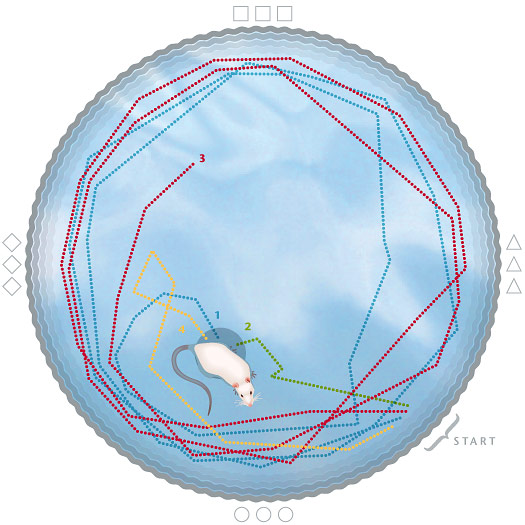Memory formation
WSU biochemical psychologists Jay Wright and Joe Harding study the chemical pathways that play a role in memory formation.
In one series of experiments, they are working to develop drugs that aid memory by “revving up” the AT4 pathway. To test their potential drugs, they have developed an animal model of dementia. (No naturally-occurring model exists.) They treat rats with a drug called scopalomine, which interferes with neurons that use acetylcholine. For the next few hours the treated rats behave in ways that look familiar to anyone who deals with dementia patients. In particular, they have trouble retaining new information. It’s not a permanent, progressive disease state, but a short-term, drug-induced inability to make new memories.
Wright and Harding test each rat by putting it into a round horse trough filled with water. There’s a small platform the rat can rest on, but it’s slightly submerged and not visible from the surface. Until the rat finds it, he has to keep swimming. Wright and Harding time how long it takes the rat to find the platform on successive days. Each rat gets one try a day, for eight days. “Demented” rats get scopalomine before each trial.
On the first day, not knowing the platform is there, the rats swim around for 90 to 100 seconds before finding it. Rats whose brains are functioning normally quickly learn where the platform is. Within a few days they swim more-or-less straight to it, reaching it in 15 to 20 seconds. A rat with drug-induced dementia, on the other hand, takes up to 75 seconds even after eight days of learning, and some never find it.
...In the key test of their potential drug, Wright and Harding gave the rats scopalomine to create dementia, and a new compound that enhances the AT4 system. After eight days of training, those rats found the platform in about 25 seconds–almost as fast as the untreated controls. It was a major finding: boosting AT4 largely compensated for the problems in the cholinergic pathway.
—from You Must Remember This, WSM Spring 2009.

WSM STAFF ILLUSTRATION
In experiments by Jay Wright and Joe Harding, rats were placed into a 6-foot diameter water tank and allowed to swim in search of a submerged platform where they could rest. Geometric symbols on the walls provided orientation clues.
1. On their first try, rats tended to stay near the tank wall but found the platform within 90 seconds.
2. After eight tries on eight successive days, the rats reached the platform in 15 to 20 seconds.
3. Rats treated with a drug that blocks the cholinergic memory system, mimicking Alzheimer’s disease, had trouble finding the platform even after eight days of training.
4. Rats treated with the blocking drug and a drug being tested for its ability to overcome memory deficits found the platform almost as fast as rats that had no drug treatment.


John W. Wright, Ph.D. (left) :: Department of Veterinary and Comparative Anatomy, Pharmacology and Physiology (VCAPP) at the College of Veterinary Medicine at Washington State University :: Research concerning memory dysfunction, such as that seen with Alzheimer's disease, and the development of new drug therapies to reduce memory problems.
Joseph W. Harding, Ph.D. (right) :: Department of Veterinary and Comparative Anatomy, Pharmacology and Physiology (VCAPP) at the College of Veterinary Medicine at Washington State University :: Research to understand the functional importance and mechanism of action of neuropeptides, especially a family of peptides called angiotensins. How these peptides regulate cardiovascular function, body water balance, and cognitive function via interactions with brain sites are of specific interest.
Photos by Robert Hubner.
